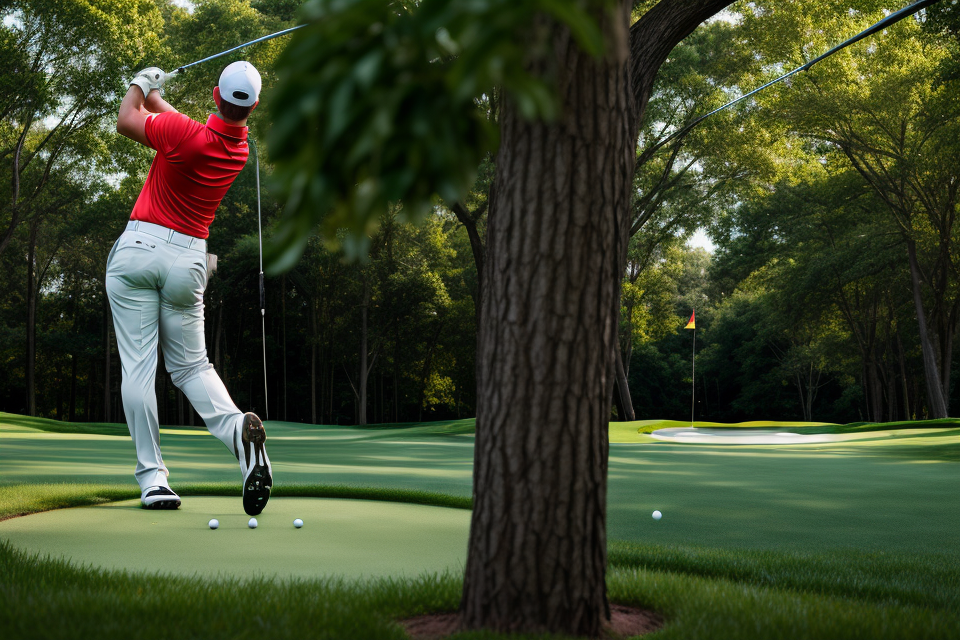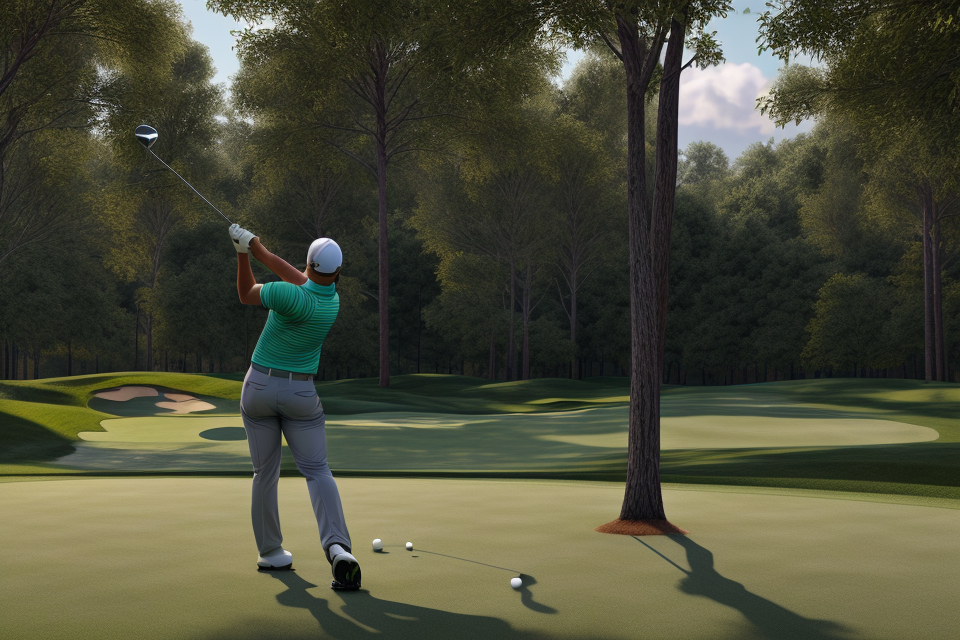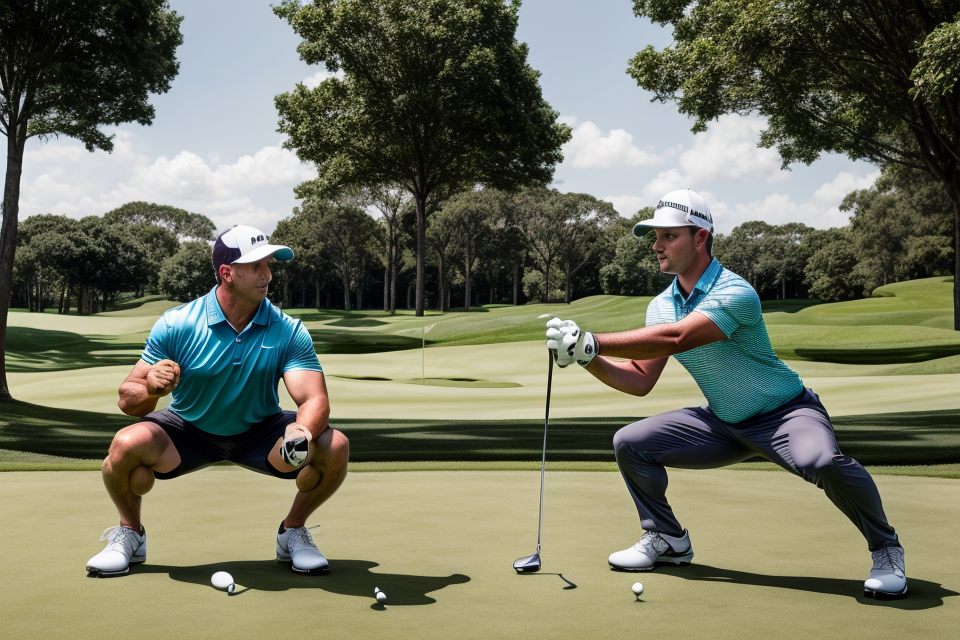
Are you tired of struggling to hit that perfect drive down the fairway? Do you find yourself losing distance and accuracy on your shots? The solution to your problems may lie in increasing your golf swing speed. A faster swing speed can result in more power and distance behind your shots, leading to more accurate and satisfying results on the course. But how can you increase your golf swing speed? This article will provide you with tips and techniques to help you improve your swing speed and hit the ball further down the fairway. From warming up properly to incorporating resistance training, these tips will help you take your game to the next level. So, get ready to tee off with more power and confidence than ever before!
Understanding the Basics of a Good Golf Swing
The Role of Posture and Stance
Proper posture and stance are essential components of a good golf swing. A correct posture provides a solid foundation for the swing, while a proper stance helps in balancing the body and generating power. Here are some key points to consider:
- Correct posture for a solid foundation: A good posture starts with standing tall and relaxed, with your feet shoulder-width apart. Keep your knees slightly bent, and avoid locking them. Engage your core muscles and tuck your pelvis to create a strong base. Ensure that your weight is evenly distributed on both feet, with your weight shifted slightly onto your front foot.
- Proper stance for balance and power: Your stance should be slightly open, with your feet pointing slightly outward. This will help you maintain balance during the swing. Place most of your weight on your back foot, with about 60-70% of your weight on the back foot and 30-40% on the front foot. Your front foot should be pointed slightly inward, toward the target. Keep your knees slightly bent, and avoid locking them.
Remember, it’s essential to maintain a consistent posture and stance throughout the swing to ensure a smooth and powerful motion. Practice and repetition are key to developing good habits and muscle memory.
The Kinetic Chain and its Importance
The sequence of movements in a golf swing
In a golf swing, the kinetic chain refers to the sequence of movements that take place from the ground up, starting with the feet, moving through the legs, hips, torso, arms, and finally the club. The kinetic chain is essential to achieving a powerful and efficient golf swing. By understanding the sequence of movements, golfers can identify areas where they may be losing power or control, and make the necessary adjustments to improve their swing.
Ensuring fluid motion and transfer of power
A crucial aspect of the kinetic chain is ensuring fluid motion and the transfer of power throughout the swing. Golfers must focus on maintaining balance and stability throughout the swing, transferring power from the ground up and through the swing. This involves using the lower body to generate power and transfer it to the upper body, allowing for a smooth and efficient transfer of energy to the club. By focusing on a fluid motion and the transfer of power, golfers can improve their swing speed and increase their overall power.
Grip and Stroke Techniques
Proper grip and stroke techniques are crucial for achieving a good golf swing speed. The following are some tips and techniques to help you improve your grip and stroke techniques:
Proper Grip for Control and Power
- The most common grip used in golf is the overlapping grip, where the little finger of the right hand rests on top of the index finger of the left hand. This grip allows for better control and power during the swing.
- Another important aspect of the grip is the placement of the hands on the club. The hands should be placed slightly ahead of the clubhead, allowing for a smooth and powerful swing.
- The grip pressure should be firm but not too tight, as this can lead to tension and loss of power.
Stroke Techniques for Accuracy and Speed
- The most important stroke technique is the backswing, which should be smooth and controlled. The backswing should be a full shoulder turn, allowing for maximum power and speed.
- The downswing should be a controlled movement, with the arms and body working together to deliver the clubhead to the ball.
- The impact should be made with the clubhead square to the target, ensuring accuracy and maximum power.
- The follow-through should be a natural extension of the swing, with the arms and body continuing to move in the same direction.
Overall, improving your grip and stroke techniques requires practice and patience. By focusing on these tips and techniques, you can improve your golf swing speed and achieve greater power and accuracy on the course.
Incorporating Drills and Exercises into Your Training Routine
Warm-Up Drills
To optimize your golf swing speed, it is essential to incorporate a comprehensive warm-up routine into your training regimen. This will not only help to prevent injuries but also enhance your overall performance on the course. The following are some effective warm-up drills that you can incorporate into your routine:
- Light stretching and mobility exercises: Before beginning your warm-up drills, it is crucial to perform light stretching and mobility exercises to increase your range of motion and improve your flexibility. This will help to reduce your risk of injury and ensure that your muscles are prepared for the physical demands of your golf swing.
- Dynamic warm-up drills to prepare the muscles: Dynamic warm-up drills involve movements that simulate the actions of your golf swing, such as shoulder circles, arm swings, and leg swings. These drills help to increase blood flow to the muscles, improve your balance and coordination, and activate your muscles in preparation for your swing.
Additionally, you can also incorporate other exercises such as light jogging, jumping jacks, and lunges to increase your heart rate and elevate your body temperature. This will help to prepare your cardiovascular system for the physical demands of your golf swing and enhance your overall endurance on the course.
By incorporating these warm-up drills into your training routine, you can improve your golf swing speed and enhance your overall performance on the course. Remember to always take the time to properly warm up before starting your swing practice or playing a round of golf.
Strength Training and Muscle Conditioning
To improve your golf swing speed, it is important to focus on strength training and muscle conditioning. By targeting specific muscle groups, you can increase your power and improve your overall swing.
Core exercises for stability and balance
Strong core muscles are essential for maintaining balance and stability during your swing. Exercises such as planks, sit-ups, and Russian twists can help strengthen your core muscles and improve your balance.
Strength training for key muscle groups
In addition to core exercises, it is important to target specific muscle groups that are used during the golf swing. The glutes, legs, and upper body muscles all play a crucial role in generating power and speed. Exercises such as squats, deadlifts, bench press, and pull-ups can help strengthen these muscle groups.
Flexibility exercises to improve range of motion
Flexibility is also important for improving your golf swing speed. Tight muscles can limit your range of motion and slow down your swing. Incorporating stretching and flexibility exercises into your routine can help improve your range of motion and increase your power.
Remember to always warm up before starting any strength training or exercise routine, and to consult with a professional trainer or physician before beginning any new exercise program. With consistent effort and practice, you can improve your golf swing speed and increase your power on the course.
Swing Mechanics Drills
Swing speed drills for increasing power
One of the key factors in improving your golf swing speed is increasing your power. To do this, you can incorporate the following swing speed drills into your training routine:
- The “Hip Rotation Drill” involves standing with your feet shoulder-width apart and rotating your hips in a circular motion, gradually increasing the speed of the rotation. This helps to improve your hip mobility and power, which in turn can increase your swing speed.
- The “Weight Transfer Drill” involves shifting your weight from one foot to the other during your swing, focusing on transferring your weight towards the target. This helps to build strength and improve your balance, both of which can increase your swing speed.
- The “Power Finish Drill” involves finishing your swing with a full extension of your arms and a strong follow-through. This helps to build power and improve your overall swing mechanics, leading to increased swing speed.
Accuracy drills for improving aim
In addition to increasing your swing speed, it’s also important to improve your accuracy on the golf course. To do this, you can incorporate the following accuracy drills into your training routine:
- The “Target Alignment Drill” involves visually aligning your body with the target and ensuring that your eyes are focused on the ball. This helps to improve your aim and reduce your tendency to push or pull your shots.
- The “Shank Avoidance Drill” involves focusing on keeping your head still and avoiding lifting your head during your swing. This helps to prevent shanks and improve your accuracy.
- The “Proper Impact Drill” involves focusing on making solid contact with the ball and maintaining a consistent swing tempo. This helps to improve your accuracy and reduce the risk of slicing or hooking your shots.
Balance drills for consistent swings
Finally, it’s important to improve your balance and stability during your swing to ensure consistent swings and prevent injury. To do this, you can incorporate the following balance drills into your training routine:
- The “One-Legged Stand Drill” involves standing on one leg and balancing on your toes, focusing on maintaining your balance and stability. This helps to improve your overall balance and stability, which can improve your swing mechanics and reduce your risk of injury.
- The “Towel Drill” involves placing a towel on the ground and standing on it, focusing on maintaining your balance and preventing the towel from moving. This helps to improve your balance and stability on uneven surfaces, which can improve your overall swing mechanics.
- The “Posture Drill” involves standing with your feet shoulder-width apart and focusing on maintaining good posture and alignment. This helps to improve your balance and stability, which can improve your overall swing mechanics and reduce your risk of injury.
Mental Preparation and Visualization Techniques
- Developing a pre-shot routine
Developing a pre-shot routine is an essential aspect of mental preparation for golfers. This routine should be tailored to each individual golfer and should be practiced consistently before each round of golf. A pre-shot routine can include activities such as taking deep breaths, visualizing the shot, and mentally rehearsing the shot. By establishing a consistent pre-shot routine, golfers can reduce anxiety and improve their focus, leading to more successful shots.
- Visualizing successful swings
Visualization is a powerful tool for improving golf performance. Golfers can improve their swing speed by visualizing themselves making successful swings. This can include imagining the ball being hit with power and accuracy, as well as feeling the physical sensations of a powerful swing. Visualization can help golfers to develop confidence and trust in their ability to make powerful swings, leading to improved performance on the course.
- Managing stress and anxiety on the course
Stress and anxiety can negatively impact golf performance, causing golfers to make errors and reduce their swing speed. To manage stress and anxiety on the course, golfers can use techniques such as deep breathing, progressive muscle relaxation, and mental imagery. By practicing these techniques regularly, golfers can learn to manage their stress and anxiety levels, leading to improved focus and performance on the course.
Tips for Optimizing Your Golf Swing Speed
Proper Equipment and Club Selection
When it comes to improving your golf swing speed, having the right equipment and selecting the appropriate clubs are crucial factors to consider. By choosing the right clubs for your swing and adjusting your equipment for optimal performance, you can enhance your power and control during the swing.
Choosing the Right Clubs for Your Swing
- Understanding Your Swing Type: Determine whether you have a steep, shallow, or neutral swing. Each type requires different clubhead designs and shaft flexibility.
- Fitting Sessions: Visit a professional fitter to have your swing analyzed and receive personalized recommendations for equipment.
- Swing Speed: Consider your swing speed when selecting clubs. Faster swingers may benefit from heavier clubs, while slower swingers may prefer lighter ones.
Adjusting Equipment for Optimal Performance
- Shaft Flex: Choose a shaft with the appropriate flex for your swing speed and style. Too flexible, and you may lose control; too stiff, and you may struggle to generate power.
- Clubhead Speed: Select a clubhead with a design that complements your swing speed. Faster swingers may benefit from a larger, more forgiving clubhead, while slower swingers may prefer a smaller, more controlled design.
- Grip Size: Ensure that your grip size is comfortable and allows for proper hand positioning during the swing.
By paying attention to proper equipment and club selection, you can optimize your golf swing speed and achieve greater power and accuracy on the course.
Developing a Consistent Swing
Consistency is key when it comes to improving your golf swing speed. A consistent swing will help you develop muscle memory, which in turn will allow you to repeat your swing without having to think about it. This is especially important when under pressure during a game. Here are some tips for developing a consistent swing:
Repetition and Muscle Memory
Repetition is the key to developing muscle memory. The more you repeat a particular swing, the more ingrained it becomes in your muscles. It is important to practice your swing regularly, ideally at least three times a week, to help develop muscle memory. However, it is also important to ensure that you are not over-practicing, as this can lead to fatigue and injury.
Focusing on Proper Technique
In addition to repetition, focusing on proper technique is essential for developing a consistent swing. This means paying attention to the small details of your swing, such as the position of your hands, the angle of your clubface, and your body position. By focusing on these details, you can make sure that you are using the correct muscles and making the best use of your body’s natural movements.
One way to improve your technique is to use video analysis to review your swing. This can help you identify any areas where you may be deviating from proper technique and make adjustments accordingly. It is also helpful to get feedback from a golf instructor, who can provide personalized tips and guidance to help you improve your swing.
In conclusion, developing a consistent swing is essential for improving your golf swing speed. By focusing on repetition and proper technique, you can develop muscle memory and make the best use of your body’s natural movements. Regular practice and seeking feedback from a golf instructor can also help you refine your technique and improve your swing over time.
Practicing on the Course
One of the most effective ways to improve your golf swing speed is by practicing on the course. Here are some tips to help you optimize your practice sessions:
Taking advantage of practice facilities
Many golf courses offer practice facilities, such as driving ranges and putting greens, that can help you improve your swing speed. These facilities allow you to work on specific aspects of your swing, such as power and accuracy, in a controlled environment. It’s important to take advantage of these resources to develop a consistent and powerful swing.
Applying lessons learned on the course
Another way to improve your swing speed is by applying the lessons you learn on the course during your actual rounds. This means taking note of what works and what doesn’t during your shots and adjusting your technique accordingly. By applying these lessons to your practice sessions, you can develop a more effective and efficient swing that will help you hit the ball further and faster.
It’s also important to remember that practice should be fun and enjoyable. While it’s important to focus on improving your swing speed, it’s equally important to enjoy the game and have fun while doing it. This will help you stay motivated and engaged in your practice sessions, and ultimately lead to greater improvement over time.
Continuous Improvement and Evaluation
Improving your golf swing speed requires a continuous process of evaluation and improvement. This section will provide tips on how to monitor your progress, adjust your technique, seek feedback, and stay motivated.
Monitoring Progress and Adjusting Technique
It’s essential to keep track of your progress and make necessary adjustments to your technique. This can be done by using technology such as launch monitors or tracking software to measure clubhead speed, ball speed, and other crucial metrics. Additionally, keeping a journal of your swings can help you identify patterns and areas for improvement.
Seeking Feedback from Coaches and Peers
Seeking feedback from coaches and peers is an essential part of the improvement process. Coaches can provide valuable insights into your swing mechanics and offer guidance on how to improve your technique. Peers can also offer helpful feedback and suggestions based on their own experiences.
Staying Motivated and Committed to Improvement
Improving your golf swing speed requires commitment and motivation. Set achievable goals and celebrate your successes along the way. It’s also essential to stay focused and avoid getting discouraged by setbacks or negative feedback. Remember that improvement is a process, and it takes time and effort to see results.
By following these tips, you can continue to improve your golf swing speed and increase your power on the course.
FAQs
1. What are the key factors that affect my golf swing speed?
The key factors that affect your golf swing speed include your physical strength, flexibility, and technique. Strength is important because it allows you to generate power, while flexibility is important because it allows you to make a smooth, unrestricted swing. Technique is also important because it determines how efficiently you transfer your body’s energy into the golf club.
2. How can I improve my physical strength for golf?
To improve your physical strength for golf, you should focus on exercises that target the muscles used in the golf swing, such as the legs, hips, and core. Exercises like squats, deadlifts, and planks can help build the strength and stability needed for a powerful swing. It’s also important to maintain good flexibility and mobility, as this will allow you to make a smooth, unrestricted swing.
3. How can I improve my technique for a faster golf swing?
To improve your technique for a faster golf swing, you should focus on making a smooth, unrestricted swing that efficiently transfers your body’s energy into the golf club. This means keeping your hands and arms relaxed, using your legs and hips to generate power, and maintaining good posture and balance throughout the swing. You should also pay attention to your grip, as a strong, neutral grip will help you control the club and generate power.
4. What are some drills I can do to improve my golf swing speed?
There are many drills you can do to improve your golf swing speed, including swinging weighted clubs, using resistance bands, and doing speed drills with lighter clubs. These drills can help you build strength, improve your technique, and develop the muscle memory needed for a faster swing. It’s also important to practice your swing regularly, as this will help you develop the muscle memory and confidence needed to swing faster on the course.
5. Can improving my mental game help me increase my golf swing speed?
Yes, improving your mental game can help you increase your golf swing speed. A positive mental attitude, focus, and confidence can all help you swing faster and more consistently. It’s important to stay relaxed and focused on the shot at hand, rather than worrying about your swing speed or other aspects of the game. By trusting your technique and focusing on the process of making a good swing, you can increase your swing speed over time.


